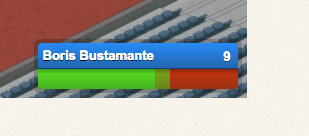
Do you know what burst energy is?
Have you ever wondered why the players' energy bar in the match viewer sometimes has 3 colours?

This is actually one of the least documented features of the match simulation. I'll get back to what it means in a bit.
It has now been several years since we implemented a new match simulator, and it was an enormous technical challenge.
But, when we finally released it, we were honestly exhausted and needed a change. So, we never got around to giving the simulator the kind of follow-up and polish that's often necessary in order to make a system - which might well be a huge technical achievement - pleasant to use, easy to understand and above all entertaining.
There were quite a few things on our list of things to improve, add or finish in the match viewer, match simulator and tactics editor after release, which we never got around to.
For instance, the simulator actually supports curve balls, but we never implemented the logic that's necessary for the players to decide when it would be advantageous to curve the ball. So, the players have the ability to curve the ball, but they never do.
A large part of the time we spent on development when towards making the simulator så flexible and expandable that we'd be able to add any player behaviour we could ever want in the future. A few years ago, we actually capitalised on this flexibility when we added streakers to the matches played on April 1st. The streakers only took about a day to implement, because the simulator contains a huge library of different behaviours, logic and movement patterns, which we can put together like Lego bricks and create new exciting incidents.
We also never documented the function and details of the simulator and that has given rise to confusion, misunderstandings, myths and even conspiracy theories.
This blog post is the first in a series meant to correct this, dispel myths and hopefully give everybody a better understanding of how deep and complex the simulation is, which concrete weaknesses it has, and which possibilities we have for future improvement.
Burst energy
So let's take a look at burst energy. It is a feature that has been in the match simulator right the beginning, but most people have no idea that it exists.
Players have 2 different kinds of energy: burst energy and "normal" energy.
The burst energy is the one that is included in the many factors, which determine players' physical capabilities and prowess at performing actions during the match. It decreases quickly during certain types of physical exertions and rises again when the player catches his breath.
The "normal" energy declines steadily throughout the match and acts as a ceiling for the burst energy. The burst energy can never exceed normal energy.
The actions which currently make burst energy deplete are:
- Running with the ball: For every second that a player runs with the ball, with opponents hot on his heels, he will lose 4 percentage points of burst energy.
- Tackling attempts: A tackling attempt costs 20 percentage points of burst energy.
- Dribbling: Trying to counter a tackling attempt costs 10 percentage points of burst energy.
When the player is not performing any of these actions, his burst energy rises by 0.2 + stamina / 260 percentage points per iteration (an iteration is a quarter of a second in real time)
That means that if a player has 10 stamina, then his burst energy will increase by 0.95 percentage points per second. If his stamina er 50, then it will rise by 1.57 percentage points per second, and 2.34 if his stamina is 100.
The reason we added burst energy was that during development we observed situations where a single player could run from one side of the pitch to the other with that ball, and shake off one tackling attempt after another if he was lucky. And, sometimes not a single opponent was ever able to catch up to him. It looked downright silly.
Burst energy has the effect that a large number of defenders had a better chance at stopping a better player since every tackling attempt would drain his burst energy bit by bit. It also made passing much more important, since there was now an advantage to letting a less exhausted teammate take over.
If we are to point out a few ways in which this system could be improved in the future, then it might be to make the energy bar smaller and have it follow overhead of the players that are in focus. It can be pretty difficult currently, to keep an eye on both the energy bar and what the player is doing.
You could also consider making more actions consume burst energy, for instance in the situations where players sprint over a short distance.
Future blog posts
I will be writing more blog posts regularly, each time going into detail about a specific part of the simulation. Some of the things I will touch upon will be:
Finishing
- How does the player choose which point to aim for?
- How is the precision of the kick calculated as a function of the player's abilities?
Player physical abilities
- How are the maximum speed and acceleration of players calculated?
- How does acceleration work?
Tackling and dribbling
- How is the duel between two players settled?
The keeper
- How do we determine whether or not the keeper is successful in catching the ball?
- What determines how far the keeper can reach?
Running with the ball
- How does the player determine which direction to move, when he has to both evade opponents and seek towards the goal?
- How does the player evaluate the threat level and decide when it's time to pass the ball to another player?
Play style and mentality
- Which concrete effects do the different play styles and mentality settings have?
- Is there any one play style that is far superior to all of the other and is there something that can be adjusted?
Formation
- How do players adhere to the formation you've set?
- How does the formation move, expand and contract according to play style, mentality and ball possession?

 Bubbles,
Bubbles,